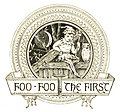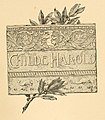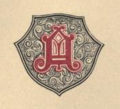| Ludvig Sandöe Ipsen | |
|---|---|
 Ipsen c. 1886 Ipsen c. 1886 | |
| Born | (1840-04-20)April 20, 1840 Copenhagen, Denmark |
| Died | 1920(1920-00-00) (aged 79–80) Malden, Massachusetts, US |
| Nationality | Danish-American |
| Known for | Book illustration, graphic and decorative design |
| Notable work |
|
| Children | Ernest Ludvig Ipsen |
| Years active | 1870s-1900s |
| Signature | |
Ludvig Sandöe Ipsen (April 20, 1840 – 1920) was a Danish-American artist and designer. Trained as an architect, he is known for his designs in a wide variety of disciplines.
Early life and education
Ludvig Sandöe Ipsen was born on April 20, 1840, to Ludvig Ipsen and Mette Margrethe Ipsen (née Bøgh) in Copenhagen, Denmark.
He trained as an architect at the Royal Danish Academy of Fine Arts, School of Architecture in Copenhagen. In 1860, shortly after graduation, he entered the military, serving in the engineering corps and participating in the Second Schleswig War in 1864.
Career
After military service, Ipsen worked for a few years in the office of a Copenhagen architect before emigrating to the United States. He found work with the Boston architect Henry W. Hartwell, and was later a member of the firm Hartwell & Swasey. By 1875, he had abandoned the practice of architecture in favor of the decorative arts and illustration. He did, however, return to architecture at least once, for the design of a crematorium chapel.
Book illustration
Ibsen was employed as a staff illustrator by the James R. Osgood publishing firm in Boston and also worked for several other local publishers.

- The Skeleton in Armor by Henry Wadsworth Longfellow (1877)
- The Scarlet Letter by Nathaniel Hawthorne (1878)
- The Confessions of a Frivolous Girl by Robert Grant (1880)
- The Prince and the Pauper by Mark Twain, sharing illustration credit with Frank T. Merrill and John J. Harley. (1881)
- The Lady of the Lake by Sir Walter Scott (1883)
- Marmion by Sir Walter Scott (1885)
- Eudora by M. B. M. Toland (1888)
The book that brought Ipsen the most acclaim was Sonnets from the Portuguese by Elizabeth Barrett Browning, issued in 1886 by Ticknor and Company of Boston.
Other works on paper
Shortly after the Boston-based men's choral society, the Apollo Club, was incorporated, Ipsen was commissioned by Arthur Reed, the club secretary, to illustrate the club's publications, and he designed 130 program covers over the course of 23 years, as well as designing the club's seal in 1876. The club's records, now held by the Massachusetts Historical Society, include fifty-one original illustrations created for Apollo Club concert programs.
Typography
In 1903, Ipsen was granted two patents for typefaces created for the American Type Founders Company (ATF): Florentine Bold Condensed (pat. no. 36,366) and Florentine Bold Extra Condensed (pat. no. 36,367). The fonts were variants of the Florentine typeface which first appeared in the ATF 1896 catalog. That catalog did not acknowledge a designer but the typographical historian Max McGrew credited Ipsen and the National Museum of American History holds original drawings for the related font Florentine Heavy dated 1896 and ascribed to Ipsen. He also designed decorative borders and initials for ATF.
-
 Florentine Bold Extra Condensed font, ATF catalog, 1912
Florentine Bold Extra Condensed font, ATF catalog, 1912
-
 Decorative borders, ATF catalog, 1900
Decorative borders, ATF catalog, 1900
-
 Decorative initials, ATF catalog, 1900
Decorative initials, ATF catalog, 1900
Architecture and architectural elements
In 1893, the Massachusetts Cremation Society opened a crematorium designed by Ipsen and built of Roxbury felsite in the neoclassical style. Now owned by Forest Hills Cemetery, it includes the Lucy Stone Chapel, named after the Boston abolitionist and suffragist who was the first person cremated there.
Ipsen received a commission in 1910 to design a pair of iron gates for the Converse Memorial Library, which was designed by H. H. Richardson, in Malden. The gates enclose a garden designed by Frederick Law Olmsted.
Personal life
Ipsen emigrated to the United States in 1867, arriving first in New York, where he married Emma Petrea Petersen (1846–1914) in Manhattan on August 10, 1868. Emma, also born in Copenhagen, was a well-known mezzo-soprano who performed in recital halls and churches. She was the sister of John Petersen (1839–1874), a marine painter also known as Johan Erik Christian Petersen.
The couple had moved to Malden, Massachusetts by the following year when their son, Ernest, was born. Ernest Ludvig Ipsen (1869–1951) became an internationally renowned portrait painter.
Gallery
-
 L. S. Ipsen, The Prince and The Pauper chapter heading, 1881
L. S. Ipsen, The Prince and The Pauper chapter heading, 1881
-
 L. S. Ipsen, Half-title illustration, Childe Harold's Pilgrimage by Lord Byron, 1886
L. S. Ipsen, Half-title illustration, Childe Harold's Pilgrimage by Lord Byron, 1886
-
 L. S. Ipsen, Title page ornament, The Scarlet Letter, 1878
L. S. Ipsen, Title page ornament, The Scarlet Letter, 1878
-
 L. S. Ipsen, Contents page header, The Scarlet Letter, 1878
L. S. Ipsen, Contents page header, The Scarlet Letter, 1878
-
 Sir Walter Scott, Marmion, Canto 6, illustrated by Ludvig S. Ipsen, 1885
Sir Walter Scott, Marmion, Canto 6, illustrated by Ludvig S. Ipsen, 1885
-
 Sonnets from the Portuguese, title page, 1886
Sonnets from the Portuguese, title page, 1886
References
- "Danmark Kirkebøger, 1484-1941," database with images, FamilySearch (https://www.familysearch.org/ark:/61903/1:1:QGQM-BS4D : 17 August 2021), Ludvig Sandoe Ipsen, 1855; Confirmation, Garnisons, Copenhagen, Denmark, , Rigsarkivet, København (The Danish National Archives), Copenhagen.
- From "American Printer and Lithographer, Volumes 3-4:"
- "Some Designs by Mr. Ipsen". The Boston Globe. November 5, 1886. p. 6. Retrieved May 23, 2022.
- "Sonnets from the Portuguese". The American Bookmaker. III (4). New York: Howard Lockwood & Co.: 106–108 October 1886. Retrieved May 23, 2022.
- Martin, Susan (September 17, 2014). "The Art of Ludvig Sandṏe Ipsen". Massachusetts Historical Society: Beehive. Massachusetts Historical Society. Retrieved May 22, 2022.
- "Design for a font of type".
- "Design for a font of type".
- McGrew, Max (1993). American Metal Typefaces of the Twentieth Century. New Castle, Delaware: Oak Knoll Books.
- "Florentine Heavy".
- "Awaiting Incineration". The Boston Globe. October 13, 1893. p. 4. Retrieved May 23, 2022.
- "Malden Public Library's historic gates restored". Neighborhoodview.org. Malden, Massachusetts. August 1, 2016. Retrieved May 23, 2022.
- "Massachusetts Deaths, 1841-1915, 1921-1924," database with images, FamilySearch (https://familysearch.org/ark:/61903/1:1:N4ZN-JLZ : 2 March 2021), Ludvig S Ipsen in entry for Emma Petrea Ipsen, 05 Mar 1914; citing Medford,,Massachusetts, 72, State Archives, Boston; FHL microfilm 2,404,363.
- "New York, New York City Marriage Records, 1829-1940," database, FamilySearch (https://familysearch.org/ark:/61903/1:1:24ZR-KJG : 10 February 2018), Ludvig Ipsen and Emma Petersen, 10 Aug 1868; citing Marriage, Manhattan, New York, New York, United States, New York City Municipal Archives, New York; FHL microfilm 1,544,135.
- "Danmark Kirkebøger, 1484-1941", database with images, FamilySearch (https://www.familysearch.org/ark:/61903/1:1:QG3B-GPJW : 17 August 2021), Emma Petrea Petersen, 1846.
- Emma Ipsen obituary
- "Obituary for John E. C. Petersen". Boston Evening Transcript. March 20, 1874. p. 1.
- https://www.familysearch.org/ark:/61903/1:1:FXZ2-GX3 Birth record for Ernest L. Ipsen
Sources
- Truesdell, Winfred Porter (1904). The Book-plates of Ludvig Sandöe Ipsen. Boston: The Truesdell Press. Retrieved April 24, 2022.
- The American Bookmaker, Volumes 3-4. New York: Moore Publishing Company. 1887. Retrieved April 24, 2022.
External links
- Works by Ludvig Sandöe Ipsen at Open Library
- Works by Ludvig Sandöe Ipsen at Project Gutenberg
- Works by or about Ludvig Sandöe Ipsen at the Internet Archive
| This article needs additional or more specific categories. Please help out by adding categories to it so that it can be listed with similar articles. (April 2022) |